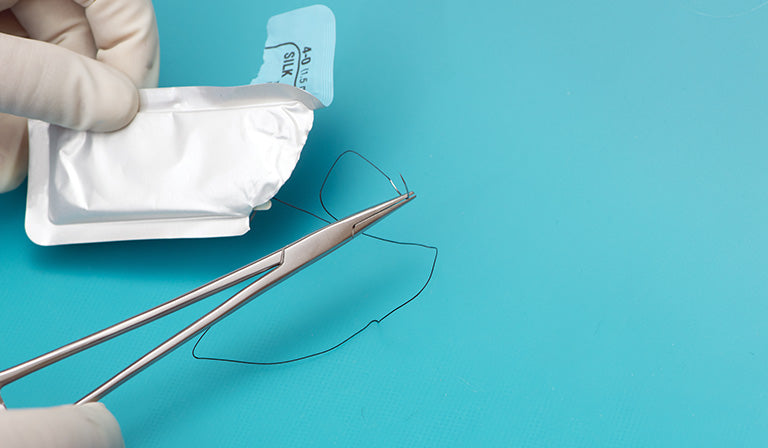

· By Trevor Horne
Key Terms Used To Characterize Suture Materials
To close your skin or other tissues, whether it is a wound or intentional incision, doctors use sutures. They will “stitch” a wound shut with a length of "thread" with a needle attached to the end when suturing. Veterinary clinics use sutures, dentists, surgeons, ER doctors, and more.
However, because suture types differ in materials used, advantages, and disadvantages, precise sutures are used for specific procedures.
Here we will look at how suture materials are classified and some of their characteristics.
Suture Materials Classification
There are different ways of classifying suture materials. They are as follows:
- By physical thread configuration (braided, twisted, multi-filament, monofilament)
- By size
- By whether they are non-absorbable or absorbable
Non-Absorbable and Absorbable Sutures
Generally speaking, within three months, absorbable suture materials lose most or all of their tensile strength. Absorbable sutures can be degenerated across different processes, such as enzymatic degradation and hydrolysis. Absorption rate also increases if patients have fever, protein deficiency or an ongoing infection.
On the other hand, nonabsorbable sutures may retain, for as much as three months or more, most of their initial strength. Nonabsorbable sutures offer longer duration in terms of tissue approximation. Nonabsorbable sutures are usually used for anastomosis (vessel repair), endor repair and bowel repair. Some nonabsorbable sutures made of prolene are used for vascular anastomoses, caesarean sections and abdominal wall closures.
With both of those things said, for a period beyond 2 to 3 months, the tensile strength of absorbable sutures has been increased thanks to new synthetic long-lasting products.
Different Sized Sutures
In addition to absorbability, size can be used to classify sutures. To describe size, two standards are currently used. They are as follows:
- European Pharmacopeia or EP
- United States Pharmacopeia or USP
Most commonly used here in America is the USP standard. Two Arabic numbers are used in a series combination to represent the size. The numbers used are zero and then any other number. For example, 3/0 or 3-0. The suture material is finer, the higher the first number. Denoted by 1,2,3, etc. are sizes larger than 1/0 or 0. Suture material can also vary with this type of suture.
Code ranges from 0.1 to 10 are used for the EP standard. Synthetic absorbable and natural forms are not separated in the EP standard (as they are in USP).
Physical Configuration Classification
Sutures can also be classified by physical thread configuration. These are as follows:
- Braided – Polyamide-based, polyester-based, silk, etc. are available in a braided multifilament configuration. With many small threads braided, it provides more security though the downside is that the probability of infections are higher.
- Twisted – Cotton, reconstituted collagen, and catgut are available. In twisted multifilament configurations, stainless steel sutures are available
- Multifilament – Sutures made from stainless steel, polyester, and nylon are available.
- Monofilament – Sutures made from stainless steel, polyester, and nylon are available.
Why does suture material matter? Certain materials perform better when the chance of infection is increased. Other types of suture materials simply cannot be used if an infection is already present or threatens.
Additionally, some materials knot better than others, knots hold better/longer, and tensile strength comes into play as well. Stiffer materials may be harder to handle while more flexible materials are easier to use.
Need Sutures? ProNorth Medical Corporation Has You Covered
Since 2011, we've been at the forefront of the medical industry supplying surgical masks, isolation gowns, sutures, and other PPE… as well as veterinary and dental items. Your patients deserve cutting-edge equipment! We are steadfastly committed to assisting healthcare professionals in lowering costs and improving patient outcomes.